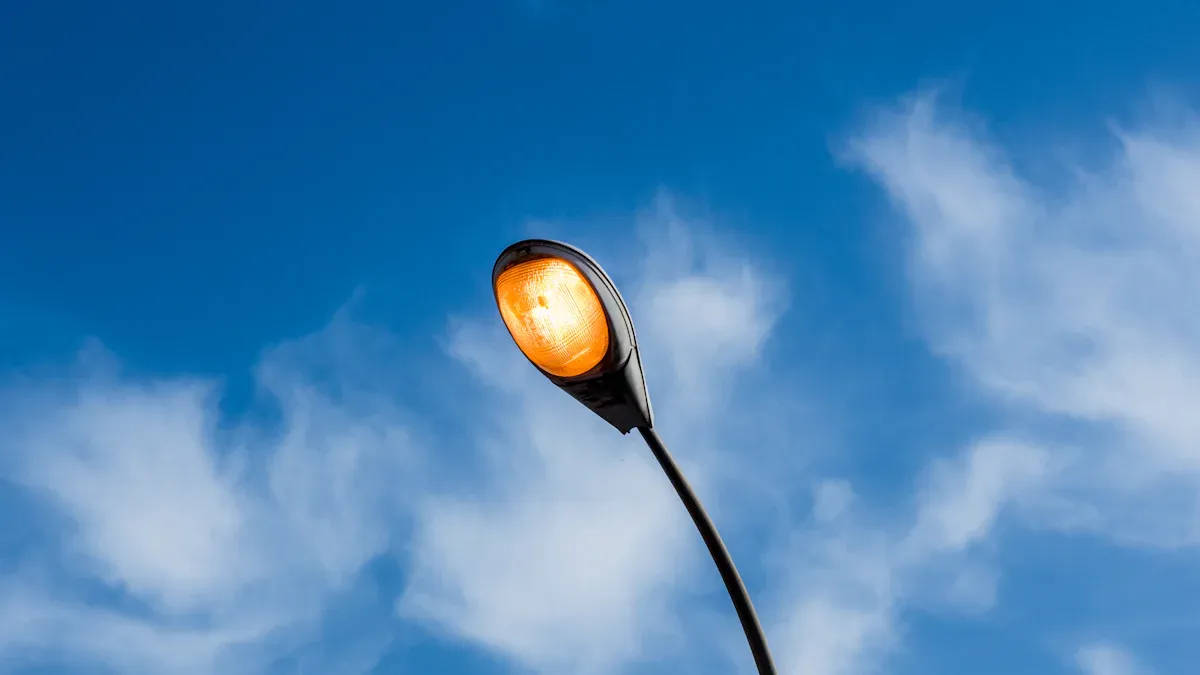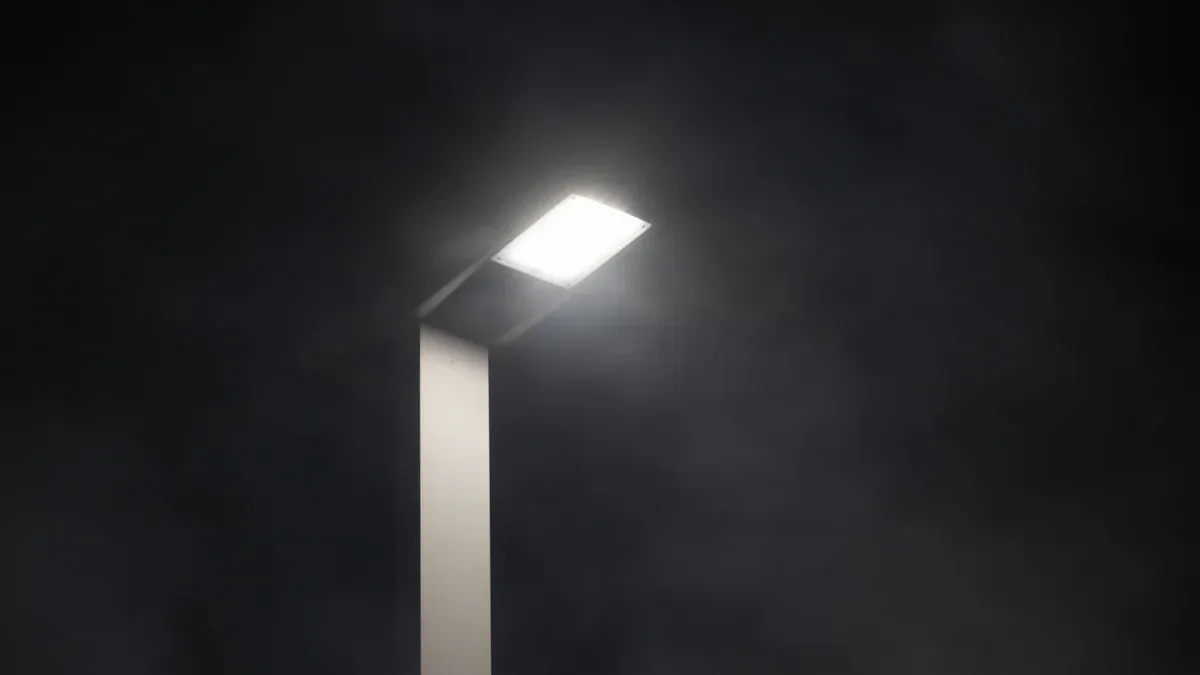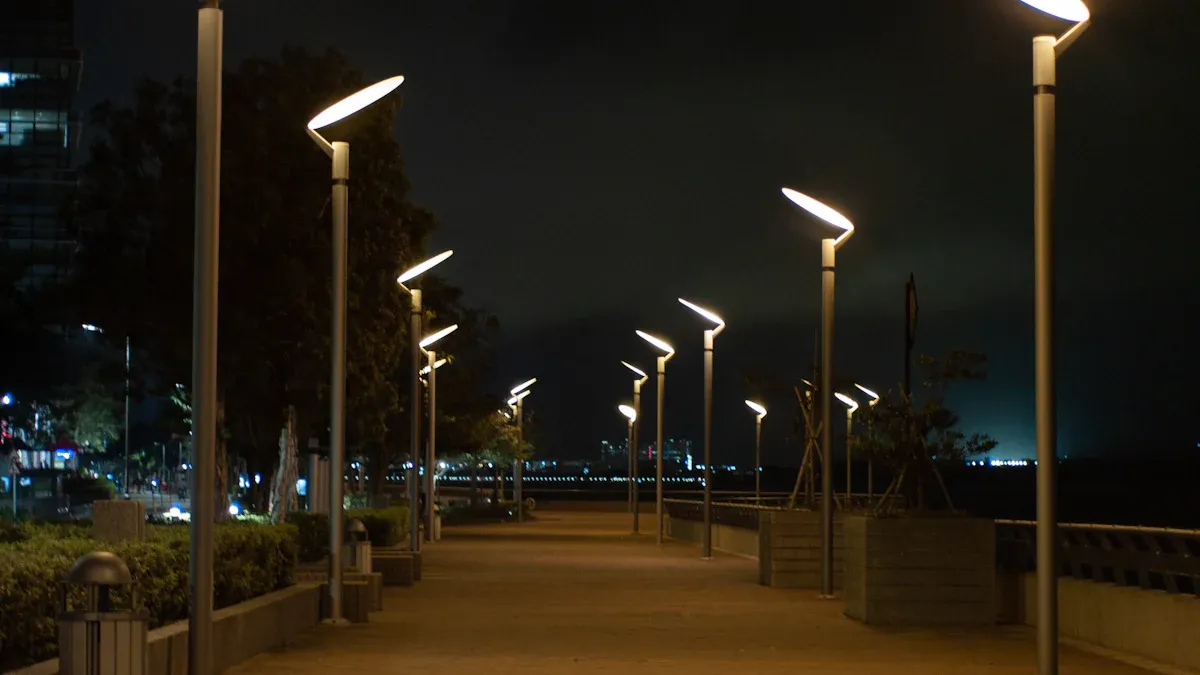How to Pick the Perfect LED Street Light for Local Projects

When you want to choose the right LED light for your home or neighborhood, focus on what your community needs and what fits its style. In the past five years, more communities have switched from traditional lighting to LED streetlights, jumping from 1% to 10%. This shift shows people want better lighting and energy savings. You might worry about quality or cost, but picking a reliable product can help reduce repairs and keep everyone safer. Good street lighting can cut crime by up to 36%. With a clear plan, you can make your choices about Home, About Us, and Product work for your community and find the best LED light for your streets.
Key Takeaways
Think about what your community needs before picking LED street lights. You should look at safety, saving energy, and how the lights look. This helps you make smart choices.
Pick the right brightness and color temperature for your area. Use the suggested lux levels to keep people safe and comfortable. This helps both walkers and drivers.
Check the IP rating to see how tough the lights are. A higher rating means the lights are better protected from dust and water. This makes the lights last longer.
Choose lights that use less energy. LED lights can cut energy costs by up to 70%. This helps save money and is good for the environment.
Ask people in your community what they think before deciding. Get their opinions on styles and features. This makes sure the project fits what locals want.
Project Needs
Purpose & Area
Before you Choose the Right LED Light, think about why your community needs new street lighting. Maybe you want to make roads safer, help drivers see better at night, or encourage people to walk and shop after dark. Here are some common reasons communities install LED street lights:
Improve traffic flow and help drivers at intersections
Reduce congestion and make the city look better
Use less energy and support green goals
Lower carbon emissions
Make streets safer for everyone
Support local businesses and evening activities
You should also look at the size and type of area you want to light. The width of the road, the number of lanes, and the layout all affect what kind of lights you need.
Brightness & Coverage
Getting the right brightness is important. Too much light can waste energy, but too little can make people feel unsafe. Check out this table to see what works best for different spaces:
Public Space | Recommended Lux Levels |
|---|---|
Residential Streets | 10–30 lux for roads; 50 lux or more for busy crossings |
Walkways | 5–10 lux for safe walking |
Parks | 5–20 lux to keep a natural feel |
Playgrounds | 20–30 lux for safe play |
Sports Fields | 300+ lux for games and events |
The number and placement of lights depend on the area’s size and shape. You need to think about pole height, spacing, and how evenly the light spreads. Try to keep lighting uniform so there are no dark spots.
Color Temperature
Color temperature changes how a street feels at night. Cooler colors (4000K-5000K) make things look brighter and help drivers see better. Warmer colors (3000K-4000K) feel softer and reduce glare, but they might not light up the area as much. Here’s a quick guide:
Color Temperature (K) | Impact on Visibility and Ambiance |
|---|---|
4000K - 5000K | Good for busy areas, helps people see clearly, saves energy |
3000K - 4000K | Warmer look, less glare, but not as bright |
Community Style
Every community has its own style. Some neighborhoods want classic-looking lights, while others like modern designs. Many people prefer warmer lights because they feel more welcoming. You can also find lights that match your town’s colors or themes. When you Choose the Right LED Light, think about what fits your community’s look and values. Energy-saving options are popular, especially if your town cares about the environment.
Tip: Ask neighbors or local leaders what style and color they like best. This helps everyone feel included in the project.
Choose the Right LED Light Features

When you want to Choose the Right LED Light, you should look at more than just how bright it is or how it looks. The technical features are important too. These features help your lights last longer and save energy. They also make sure your lights work well in your local weather. Let’s look at what you should check before you decide.
Light Distribution
Light distribution is about how the light spreads on your streets. If you pick the wrong one, you might have dark spots or waste energy. You can Choose the Right LED Light by matching the distribution type to your road or area. Here’s a table to show the differences:
Light Distribution Type | Shape Description | Application |
|---|---|---|
Type II (T3) | Slightly wider with a 25-degree preferred lateral width | Suited for side-of-roadway light fixtures on narrower roads |
Type III (T4) | Medium-wide with a 40-degree preferred lateral width | Provides broader illumination for larger outdoor areas |
Type IV (T5) | Intense, even illumination from 90 to 270 degrees | Designed for wide roadways |
Type V (T5S) | Circular 360° distribution | Suitable for intersections and large areas |
Type VS | Square 360° distribution | Appropriate for uniform lighting in defined square areas |
Choosing the right pattern saves energy and money. Here’s why: LED street lights let you change optics and beam angles for each road. Customizing light distribution cuts down on light pollution and saves energy. Targeted light means you need fewer lights for the same brightness. Using fewer lights and less energy helps your town meet green goals.
Tip: Walk around your streets at night and see where the light goes. This helps you Choose the Right LED Light with the best pattern for your area.
Energy Efficiency
Energy efficiency is a big reason people pick LED street lights. You can save between 50% and 70% on energy compared to old lamps. If you add smart controls, you can save up to 80%. That’s a big difference for your budget and the environment.
When you Choose the Right LED Light, look for these certifications:
Certification | Description |
|---|---|
CE Certification | Meets EU safety, health, and environmental protection standards |
UL Certification | Proves safety and performance through tough testing |
ENEC Certification | Shows approval for electrical safety and performance |
CB Scheme | Makes global acceptance of test reports and certificates easier |
EMC Standards | Ensures no electromagnetic interference and keeps reliability high |
RoHS Compliance | Guarantees products are free from hazardous substances and eco-friendly |
Note: Certified lights not only save energy but also last longer and work safely.
IP Rating & Durability
Outdoor lights face rain, dust, and tough weather. The IP rating tells you how well your LED street light stands up to these things. The first number shows dust protection. The second number shows water resistance. Higher numbers mean better protection.
IP ratings keep your lights safe from dust and water.
IP44 works for covered places. IP67 is best for harsh weather.
High IP ratings mean less rust and damage, so your lights last longer.
You spend less on repairs and replacements.
Bad weather can make your lights wear out faster. If you live where it rains a lot or gets very hot, make sure you Choose the Right LED Light with a high IP rating.
Surge Protection
Surges can break your lights very fast. Lightning, big machines, and even elevators can send strong jolts through your system. Surge protection keeps your lights safe.
Lightning can cause big surges and break devices.
Turning big machines on or off can spike your power.
Surges sometimes come from outside your power grid.
Surge protection devices act like smart switches. They spot extra voltage and send it away from your lights. Good grounding makes these systems work better, especially during storms.
Check for these standards when you Choose the Right LED Light with surge protection:
Region | Standard/Certification |
|---|---|
United States | UL 1449, the Standard for Surge Protective Devices (SPDs) |
Canada | CSA C22.2 NO. 269 Series of SPD Standards |
Mexico | NOM-003-SCFI (NMX-J-515-ANCE) |
Global Markets | IEC/EN 61643-11, -311, -321, -331, IEC 61643-31, IEC 61051 |
Tip: Ask your supplier about surge protection. It’s worth the extra peace of mind.
Smart Controls
Smart controls make your LED street lights even better. You can change brightness, track energy use, and find problems before they get worse. These features help you save money and keep your streets safe.
Adaptive lighting changes brightness based on real-time needs.
Motion sensors turn lights on only when people or cars are nearby.
Dimming controls lower energy use during quiet hours.
Remote monitoring lets you fix problems fast and avoid downtime.
Predictive maintenance tells you when to repair lights before they fail.
Here’s a table showing how smart controls help:
Feature | Contribution to Energy Savings and Maintenance Efficiency |
|---|---|
Remote Monitoring | Quick problem-solving and less downtime |
Dynamic Dimming | Adjusts light levels for best energy use |
Predictive Maintenance | Cuts costs and boosts reliability |
Motion Sensors | Saves energy in low-traffic areas |
Dimming Capabilities | Lowers brightness during off-peak hours |
Fault Detection | Reports issues in real time, keeping streets safer |
Automated Energy Measurement | Tracks and adjusts energy use for maximum efficiency |
Cities that use smart controls can save about 50% on energy costs. With advanced systems, you can save up to 30% more. The starting cost is higher, but you get big savings and fewer repairs over time.
Note: Smart controls help you Choose the Right LED Light that fits your budget and keeps your streets bright and safe.
Layout Planning

Number of Lights
You want your streets to be safe and bright. But you do not want to waste energy. Figuring out how many LED street lights you need can be hard. There are some easy ways to help you decide. Here is a table that shows the most common ways people figure it out:
Method | Description |
|---|---|
Average Illuminance Method | Calculates average light level using standards. It looks at road type and traffic amount. |
Lumen Method | Finds total lumen output needed for the right brightness. It uses luminaire features. |
Computer-Aided Design (CAD) | Uses computer software to plan and improve lighting layouts. It checks many things for good placement. |
Most towns use the Lumen Method. It is simple and works well. You need to know the area, the brightness, and the kind of LED fixture. Here is how the formula works:
E = Illuminance (lux)
N = Number of luminaires
F = Luminous flux per luminaire (lumens)
UF = Utilization factor
MF = Maintenance factor
A = Area to be illuminated (square meters)
Tip: If you are not sure, ask your supplier for help. You can also use free online calculators. They make the math easy!
Spacing & Pole Height
Getting spacing and pole height right is important. If poles are too close, you waste energy and money. If poles are too far apart, you get dark spots. Local rules help you know what to do.
Local rules set limits for pole height and where to put them.
In busy city areas, taller poles light up wide streets. They do not blind drivers or walkers.
In quiet neighborhoods, shorter poles keep things cozy and safe. They also cause less glare.
Always check your city’s rules before you start. Walk the area at night to see where shadows fall. This helps you decide if you need more lights or can space them out. Good planning gives you bright, even lighting that feels safe and welcoming.
Note: The right layout saves energy and lowers costs. It keeps everyone happy. Match your plan to your community’s needs!
Installation & Maintenance
Compatibility
Check if your new LED street lights work with what you have. Sometimes, you can run into problems. Old street lights often use a ballast. You may need to take it out or skip it. This helps your new LEDs work well. LEDs need less power and steady voltage. You might need better wires or a new power supply. Some old fixtures do not fit LED lamps. You may need to fix or change them if they are broken.
Tip: Always check your equipment before you start. This helps you save time and money.
Accessories
You want your LED street lights to last long and work well. The right accessories help a lot. Get all the permits you need before you start. Pick the best bulb for your project. Choose strong poles or lamps for your area. Good mounting keeps your lights steady and bright.
You may also need some extra things. Resistors help control current and voltage. A transformer changes AC power to DC. You need a good power source, like batteries or solar panels. Wires and connectors make installation safe. Relays or power transistors help with more power.
Note: Always check and test your lights before you finish.
Maintenance Needs
LED street lights need less care than old lights. They last longer and break less often. This saves you time and money. Here is a table to show how LED street lights compare to old ones:
Feature | LED Street Lights | Traditional Lighting Systems |
|---|---|---|
Lifespan | 50,000 to 100,000 hours | 10,000 to 20,000 hours |
Maintenance Frequency | Less frequent replacements | Regular bulb replacements needed |
Maintenance Costs | Relatively low maintenance costs | Higher maintenance expenses |
Reliability | High reliability, fewer failures | More susceptible to malfunctions |
You will fix LEDs less and spend less money. Your community gets bright and safe streets with less trouble.
Compliance & Selection
Regulations & Standards
You need your LED street lights to follow all rules. Local and national rules keep your project safe and legal. Check for certifications before you buy anything. These marks show your lights passed safety tests. Here is a table to help you find the right marks:
Certification/Standard | Description |
|---|---|
UL Certification | Makes sure electrical products are safe and tested for fire dangers. |
CE Certification | Shows your lights meet EU safety and health rules. |
FCC Compliance | Makes sure your lights do not mess up U.S. communication systems. |
RoHS Compliance | Limits dangerous materials to help the environment. |
Energy Star Certification | Proves your lights save energy and cut greenhouse gases. |
LEED Certification | Helps with green building and sustainable projects. |
Tip: Always ask your supplier to show proof of these certifications. This helps you avoid trouble later.
Warranties
Warranties help if something breaks or does not work. You want to know how long your lights last and what help you get. Most LED street lights have a warranty from 3 to 10 years. Here is what to look for:
Good products usually have a warranty for 5 to 7 years.
The best products may give you up to 10 years.
Cheaper lights often have only 3 to 5 years.
Most LED lighting warranties are 3-5 years.
A strong warranty helps you feel safe about your lights.
Most good LED fixtures last more than 50,000 hours.
Note: Longer warranties often mean better quality. Ask what the warranty covers before you buy.
Final Checklist
Check everything before you put in your new LED street lights. This helps you find problems and get ready. Here is a table to guide you:
Step | Description |
|---|---|
Permitting and Approvals | Get permits and approvals from your local government. |
Procurement and Testing | Choose good suppliers and test your lights before installing. |
Installation and Commissioning | Follow safe steps and do things the right way. |
Maintenance and Monitoring | Plan to check your lights and change bulbs when needed. |
✅ Test your lights before you finish installing them. Change settings if you need to. This keeps your streets bright and safe.
You now have a clear path to pick the perfect LED street light for your project. Start by thinking about your community’s needs, then look at features, layout, and rules. Use the checklist to stay on track and feel confident. Good lighting does more than brighten streets—it helps people feel safe, makes neighborhoods look lively, and saves money over time.
People feel safer and enjoy being outside when streets are well-lit.
Cities save money and can invest in other community programs.
Neighborhoods with better lighting often see less crime and higher property values.
A smart lighting choice can truly transform your community! 🌟
FAQ
How do I know which LED street light is best for my area?
You should look at your street size, brightness needs, and local style. Ask your neighbors what they like. Try to match the light to your community’s goals.
Can I install LED street lights myself?
You can install small lights at home. For public streets, you need a licensed electrician. Always check local rules before you start.
What does “IP rating” mean for LED street lights?
IP rating shows how well your light handles dust and water. Higher numbers mean better protection. For rainy places, pick lights with IP67 or higher.
Do LED street lights save money?
Yes! LED street lights use less energy and last longer. You spend less on repairs and electricity. Many towns save up to 70% on lighting costs.
Are smart controls worth it for small projects?
Smart controls help you save energy and spot problems fast. For small projects, you might not need every feature. Motion sensors and dimming work well for most neighborhoods.
See Also
How to Choose the Best LED Street Light for 2025
Top 10 Essential Features for LED Street Light Installation
Ultimate Resource for Understanding LED Street Light Technology

